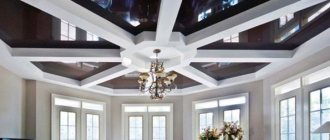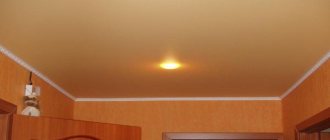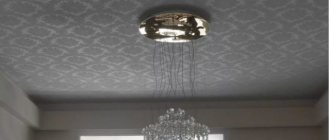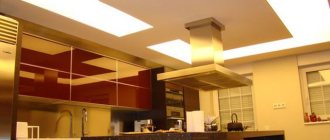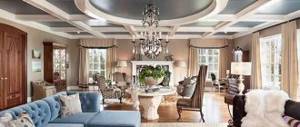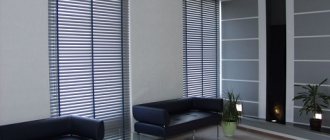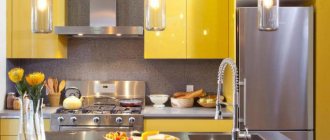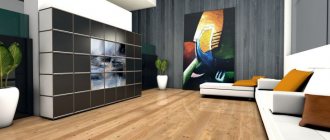Among the various options for suspended ceilings, PVC film sheets, which can have a matte or glossy surface, are especially in demand. Their popularity is due to the combination of technical characteristics and attractive appearance. However, during the renovation process, many owners of apartments and country houses have the problem of choosing a material.
What is better - glossy or matte stretch ceiling in the kitchen? To choose the best option, you need to compare the canvases, taking into account the characteristics of the room and other factors.
Characteristics of PVC film sheets
Since matte and glossy stretch ceilings are made from PVC film, the canvases have similar properties. They are characterized by the following:
- resistance to moisture and high temperatures;
- ease of installation and maintenance;
- long service life;
- safety in use;
- variety of colors and decor.
Stretch film ceilings do not emit unpleasant odors during operation and are not prone to fire or the appearance of mold and mildew. Thanks to their waterproofness, they protect the kitchen from leaks when flooded by neighbors from the upper floors.
Installation of tension sheets made of PVC film is cheaper than installation of ceiling structures made of other materials. They do not require regular updating, and plain surfaces can be painted with paints and varnishes if desired. When using suspended ceilings, there is no need to waste time and money on leveling the floor slab, and the height of the room does not change significantly when installing a single-level structure. Canvases allow you to hide communications and various architectural elements in the room.
Among the disadvantages of film ceilings are:
- a slight odor that appears immediately after installation and quickly disappears;
- the possibility of damage from sharp objects or due to shock loads, therefore, when cleaning it, do not use brushes with stiff bristles and avoid excessive pressure.
When using suspended ceilings to decorate a kitchen, you need to carefully select lighting devices. Since the PVC film sheet is deformed when exposed to too high a temperature, lamps of limited power are used. Hanging chandeliers and recessed light sources can be used to illuminate the kitchen. The power of incandescent lamps should not exceed 40 W, and halogen lamps - 35 W. LEDs can also be used as light sources.
If a chandelier with lampshades directed upward is used to illuminate the kitchen, then the distance from the light sources to the ceiling is at least 40-50 cm. Violation of these recommendations leads to overheating of the canvases and can cause yellowing of the material.
Overview of paints
Gloss levels
When talking about such compounds, we often lose sight of the fact that they can belong to different categories. And here it is very important to make the right choice, since depending on the characteristics of the coating, not only aesthetic characteristics, but also durability differ.
Most often, paints are divided into the following groups:
- Matte (marked “matt”)
. Such coatings have virtually no shine, which allows them to be used to effectively mask various surface defects. The main disadvantage is the rather high porosity of the surface, which leads to rapid contamination and complicates cleaning.
Note! Many technological compositions, such as fire-retardant paints for metal Polistil, have a matte texture.
" Egg shell" Such paints are superior to matte in terms of wear resistance, are easier to clean and are less dirty. In this case, the surface shines only when illuminated from a certain angle, which must be taken into account when developing the design.- Semi-matte or satin (“satin”)
. The treated surface has a pleasant shine, but at the same time has a clearly defined texture. Such paints are widely used when working on wood, and where the surface is subject to operational loads.
- Semi-gloss (“semi-gloss”)
. The medium gloss level of these compounds is combined with the highest wear resistance. Due to the fact that semi-gloss paint forms a coating with a minimum number of pores, after drying it becomes practically not susceptible to external influences.
Note! Semi-gloss also includes metal-based finishing materials, such as Zinga conductive paint and its analogues.
- Glossy (“gloss”)
. Give the surface maximum shine and form a perfectly smooth coating. The almost complete absence of pores makes cleaning the painted object much easier: just wipe it over the surface with a damp cloth. Widely used for indoor and outdoor decoration.
Advantages and disadvantages of glossy compounds
Acrylic, water-based or enamel paint with a high gloss level has a number of advantages:
- Firstly, as we noted above, the treated surfaces become resistant to wear and washing. It is for this reason that such materials are actively used in the decoration of public buildings (entrance walls, lobbies of schools, hospitals, etc.).
- Secondly, the shine of the painted area immediately attracts attention. That is why designers use such compositions to bring the necessary accents to the room.
However, there are also disadvantages, the main one of which is the same smooth texture:
- Firstly, gloss fits well only on perfectly flat surfaces. For example, when finishing metal, you will have to grind it very well until the slightest defects are eliminated.
- Secondly, on a perfectly smooth surface, any contamination, and primarily fingerprints, immediately catches the eye. So this paint requires maintenance much more often than matte.
I would also like to devote a few words to such a parameter as price. There is no direct relationship between the level of gloss and the cost of the material (here the quality and name of the manufacturing company comes to the fore). The only thing worth noting is the higher price tag for satin compositions, but this situation is explained by their relative rarity.
The nuances of ceilings with a glossy surface
Glossy stretch ceilings for the kitchen shine and have good reflective properties. Thanks to these properties, they create the effect of expanding space, visually enlarging the room and making it brighter. Canvases with a glossy surface look organic in both spacious kitchens and small rooms. However, their use is especially effective in small rooms with low ceilings: the mirror shine gives a feeling of spaciousness and air.
The disadvantages of glossy canvases include:
- Higher cost. Glossy ceilings are slightly more expensive than the price of suspended ceilings with a matte texture.
- Difficult to care for. When removing contaminants, there is a high probability of streaks appearing on the glossy surface. To avoid this, you need to use alcohol-containing products for cleaning and, at the end of cleaning, wipe the canvas with a 10% solution of ammonia.
- Susceptibility to deformation. Temperature changes may cause defects to appear on the glossy surface. Therefore, such canvases are installed in heated rooms and are not suitable for a summer kitchen.
Another drawback appears when using glossy canvases of small width for finishing. In this case, the connecting seam is more noticeable than when installing ceilings with a matte surface.
Main differences
Perhaps we can figure out which ceiling is better or worse by analyzing the main nuances.
- Care. A glossy surface will have to be taken care of more carefully, but if you choose a matte surface, you will simply need to periodically wipe it with a damp cloth. Matte ceilings can also be cleaned with steam if grease needs to be removed. You will have to wash the gloss very carefully so as not to damage the canvas. Gloss cleaning is often carried out by specialized companies when it comes to restaurants, offices and other public spaces.
- Price. Here again, everything is clear - glossy stretch ceilings are more expensive than matte ones. Moreover, if a seam is made when installing matte panels, the price drops even more.
- The seam. Some stretch fabrics are produced in small sizes. Because of this, it is necessary to create a single composition using seams. But if previously gloss had a width limited to about 2 meters, now both they and matte can be made up to 5 meters wide. Therefore, in this component, none of the options has advantages over the other.
- Lighting. Now the time has come to show yourself to the gloss. After all, such suspended ceilings make it possible to create something unimaginable from lamps and lighting. Some reflective fabrics are translucent and transmit light perfectly, which is why special lamps and LEDs are often placed under them. Matte surfaces have other, more limited capabilities. When using them, the use of powerful lamps is prohibited, since exposure to high temperatures is detrimental to the material. If chandeliers or spotlights are used, then they must be weak, with a power of no more than 35 W.
- Temperature effect. Reflective fabric is only suitable for heated rooms. Matte ones can be placed where there is a slight decrease in temperature. Both options in this component are inferior to their fabric counterparts, which can withstand any temperature changes.
- Design possibilities. The design of both types of suspended ceilings is quite diverse, although there are slightly more glossy ones. One way or another, this variety allows you to choose the best option for each specific interior design or idea of the owner of a house, apartment, office or restaurant. However, when it comes to multi-level ceilings, reflective stretch fabrics perform better here. If you want to create a classic style indoors, then a matte canvas will come in handy. Add to this well-organized lighting, and you will achieve a great result.
- Color. As we have already noted, in terms of color palette, gloss is more diverse. At the same time, the matte canvas will retain its original appearance longer; it will be able to absorb excess glare, which gloss cannot boast of.
It is impossible to give a definite answer to the question of which type of suspended ceilings is better or worse. It all depends on each specific goal or task that a person sets for himself when planning a renovation. Some situations require the exclusive use of reflective fabrics, others - matte ones. Plus, don’t forget that both types can be perfectly combined with each other and allow you to create real masterpieces on your ceiling.
Therefore, focus on the main advantages, and also do not forget about the features of using a stretch ceiling. Additionally, always consider alternative finishing materials. Whatever one may say, the modern market offers a huge assortment.
Features of canvases with matte texture
Matte canvases resemble the texture of a plastered, slightly rough surface. They do not shine, do not have reflective properties and do not create glare when lighting devices are turned on. Matte stretch ceilings for the kitchen are characterized by the following:
- lower cost compared to glossy canvases;
- ease of maintenance, which does not require special techniques when cleaning the surface;
- the ability to avoid seams during installation due to the use of materials whose width corresponds to the dimensions of the kitchen.
Their popularity as a finish is somewhat declining due to their limited color palette and less impressive appearance. To make a matte ceiling bright and interesting in design, photo printing and other surface decoration options are used.
Which stretch ceiling to choose? (matte, glossy or satin)
You have decided to install suspended ceilings. but are at a loss as to which one to choose? This is not surprising, since it is very difficult to navigate the variety of options offered.
Glossy, matte or satin? Which ones are better? What stretch ceiling will look perfectly smooth and fit well into the interior? . Any buyer would like to have answers to all these questions. Glossy, matte or satin ceilings are exactly the same in their technical characteristics . they do not allow water to pass through, are durable, strong, and safe. Therefore, they make a choice based on personal preferences and expected results. Since the integrity and harmony of your interior will depend on which ceiling you choose - glossy or matte. To do this, you need to objectively evaluate the room in which you need to install the ceiling.
Stretch ceilings have a lot of different textures - glossy and matte, from those already familiar to us to exotic ones (suede, fantasy and texture). In general, the most common are matte. glossy and satin. About 75% of installed suspended ceilings are glossy ceilings of imported origin.
Glossy ceilings will help create an interesting effect from a design point of view. Glossy ceilings have a bright color scheme, and since the surface of such material is perfectly smooth, moisture and condensation will not accumulate on it. Thanks to the mirror surface of the canvas, the room is visually enlarged.
The disadvantage of glossy stretch ceilings (when compared with matte and satin) is that the seam line will be more noticeable on a mirror surface. Matte canvas is a classic option. This ceiling will easily fit into any interior and will not distract attention from the decorative elements of the room. There are no glares or reflections on matte stretch ceilings, thanks to which they will accurately convey any color you choose. The advantage of matte canvas is that the surface color is durable and will not fade over the years.
Satin ceilings are similar to matte ceilings, but their relief is shallower, due to which the reflective properties of the canvas are enhanced, and it looks dazzlingly white. The satin surface gives a slight reflection of light, the canvas acquires a pearlescent hue. The advantage of this type of ceiling is that the seams on the surface are not noticeable.
Seamless ceilings consist of the finest fabric (mesh), which is impregnated with polymers on one or both sides. Seamless ceiling fabrics are produced in rolls up to 5 meters wide; individual adjustment to the shape of the premises is not required. For installation, the canvas is produced without heating or additional processing and is fixed in the mounting profile. Seamless ceilings are available in a limited range of colors (mainly white). In terms of strength characteristics, seamless ceilings are close to traditional finishing methods and are not afraid of low temperatures.
Based on these data, you can now roughly decide what type of ceiling you would like to see in your interior.
Comparison of glossy and matte ceilings
When choosing which suspended ceiling is better in the kitchen - glossy or matte, you need to take into account the cost, aesthetic appeal of the canvases and difficulty of maintenance. By comparing these factors, you can choose the best finishing option.
Matte ceilings are cheaper than glossy ceilings and are less demanding to maintain because they can be easily cleaned with a damp soft cloth or steam. They look perfect in combination with a classic interior, but can also be harmonious for a kitchen in a different style.
Glossy panels with a reflective surface create interesting visual effects, especially with the right choice of lighting fixtures. Depending on the color and decor, such canvases are used to decorate kitchens in high-tech, art deco or empire style. Glossy ceilings organically combine with modern or stylized classic furnishings. They look harmonious with different lamps, but the number of lighting devices should be carefully considered. Excessive light increases vision strain and can cause discomfort.
Features of matte ceiling
Such canvases add rigor and conservatism to the room. You don't know what to choose - glossy or matte ceiling? It’s better to take gloss if the interior style is classic. Such canvases are perfect for the bedroom. Among the features of this surface, consumers note the ability of the material to muffle glare. As a result, light is reflected without distortion. Buyers are also paying attention to a greater variety of shades. If you have to choose what to use in decorating your office, kitchen or living room - a glossy or matte ceiling, it is better to install a second one. Yellow and orange surfaces look impressive. As designers say, these colors help stimulate mental activity. In addition, with them the atmosphere becomes more solemn. Matte canvas may have a rough surface. Many consumers like this. The rough surface creates an imitation of a regular ceiling. At the same time, the room maintains a comfortable, warm atmosphere.
Main types and groups of tension fabrics
The modern construction market offers a wide selection of stretch ceiling coverings. However, if you divide them into groups, then there are three main types of such coverage:
- Fabrics based on fiberglass.
- Polyvinyl chloride ceilings or PVC film sheets.
- Stretch fabric ceilings.
Stretch ceilings based on fiberglass have recently appeared on the construction market. This material is new, and so far such coating is not in great demand. The fabrics are very textured and beautiful. This type of ceiling is always matte, tolerates temperature changes well, but does not “cooperate” well with water, so they cannot be installed in the kitchen or bathroom.
PVC film sheets are the most popular today. This ceiling is very durable and easy to care for. Polyvinyl chloride sheets are available in both matte and glossy finishes. They have a rich color palette.
Glossy slatted ceiling
Which ceiling: glossy / matte to choose for small low rooms? In this case, you should pay attention to the gloss. The slats will reflect light, making the room visually larger. Glossy slats can also come in a variety of shades and textures; you can choose the right option for any interior. Another advantage of such structures is ease of maintenance. Smooth glossy slats are easy to clean.
Glossy slatted ceilings look good in interiors decorated in modern directions. They will emphasize the original design of the office, the laconicism of a small kitchen in the spirit of hi-tech. Such designs look good with built-in lamps.
produces suspended ceiling systems, offering modern design solutions for residential and public interiors, a wide range of colors, shades and textures of decorative panels. Qualified specialists will help you decide which ceiling, matte or glossy, is best suited to your type of room. All products are made from high-quality raw materials and undergo a certification procedure.
Glossy stretch ceiling
This type of stretch fabric is more expensive than matte coatings. However, this is more than compensated for by a more diverse and rich color palette. Glossy ceilings perfectly reflect light, creating the effect of a mirror canvas and this makes the room deeper, more voluminous and larger. The canvas is ideal for rooms with low ceilings. This ceiling reflects everything in the room, making the space seem larger. This coating would look good in a hallway, bathroom or small room.
Matte and glossy stretch ceilings are constantly competing with each other. However, both types of stretch fabric look great together. Today, there are ready-made designs that consist of a combination of tension and glossy fabric. Such colored or plain ceiling structures are called combined stretch ceilings.
The most popular type of glossy stretch ceiling is “Starry Sky”. This glossy ceiling can be used in absolutely any room. It is ideal for a bedroom or nursery, as well as for a club or restaurant.
Pros and cons of suspended ceilings
The modern market offers many options for finishing the ceiling; it is not necessary to use the old method - whitewashing. Stretch ceilings have become popular because of their beautiful aesthetic appearance and the ability to disguise all the imperfections of the ceiling. But since this method came to the masses not so long ago, consumers still have questions about the material itself, whether it is harmful, how long it will last, and others. Whatever type of material you choose, they all have common advantages and disadvantages.
- Quick installation. Stretch ceilings are installed easily and simply, it will take little time and there will not be a huge amount of construction waste.
- Aesthetics of the material. The ceiling surface will look perfectly smooth and will remove all wires and ceiling imperfections.
- Durability. The warranty period for ceilings is 10 years, at a minimum. With proper care and use, the ceiling can last 30 years.
- Safety. Despite the fact that the canvas is made of PVC, they are absolutely safe, non-toxic and approved for installation in children's institutions.
- Manifold. The color spectrum of ceilings has a wide range of shades and can take on any shape. So if you have an unusual project, then you can safely turn to stretch ceilings.
- Water resistance. If you are flooded by your upstairs neighbors, the ceiling will withstand a huge amount of water. In addition, it will improve sound insulation and thermal insulation.
Ceilings have many more advantages than disadvantages, but there are also these:
- Expensive. Of course, you no longer need to spend fabulous sums on installation, but the price still remains quite high among all methods of ceiling finishing.
- Fragility. Stretch ceilings are afraid of any mechanical influences. It won't be too difficult to pierce it.
- Temperature regime. The material will not withstand cold or too much heat. At temperatures below +5 it begins to crack, and above +50 it begins to stretch.
As you can see, there are undoubtedly more pros than cons, but the cons can also be fatal when used. It is worth thinking before installing them; if you have children or pets in the house, you should protect the ceilings from external influences.
Now we will look at the advantages of certain types of suspended ceilings and how they differ.
